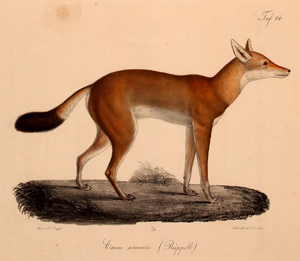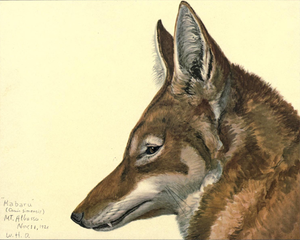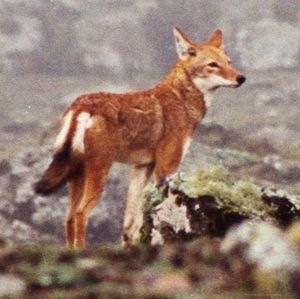الذئب الإثيوپي
(تم التحويل من ذئب حبشي)
| Ethiopian wolf[1] Temporal range: Late Pleistocene - Recent
| |
|---|---|

| |
| Southern Ethiopian wolf (C. s. citernii), جبال باله، المنتزه الوطني، إثيوپيا. | |
| التصنيف العلمي | |
| مملكة: | |
| Phylum: | |
| Class: | |
| Order: | |
| Family: | |
| Genus: | |
| Species: | C. simensis
|
| Binomial name | |
| Canis simensis روپل، 1840
| |

| |
| نطاق الذئب الإثيوپي | |
بدون دعم الإظهار، فسترى علامات الإستفهام ومربعات ورموز أخرى بدلاً من الحروف الإثيوپية. |
الذئب الإثيوپي أو ابن آوى القردي حيوان بري من عائلة الكلبيات ورتبة آكلات اللحم، يتراوح حجمه بين حجم الثعلب والذئب، لكنه شديد الشبه بالثعلب بوجهه المستدق الطرف وأذنيه الكبيرتين وجسمه، وهو خفيف البنية وله سيقان طويلة الجزء السفلي منها أبيض، ومعطفه أحمر وتحيط بعنقه حلقتان قرميديتان حمراوتان، وذيله بنتهي بطرفٍ أسود ويبلغ طول رأسه وجسمه حوالي 100 سم ويزن نحو 10 كگ.
الأسماء المحلية
| المجموعة اللغوية أو المنطقة | الاسم المحلي | الترجمة الحرفية |
|---|---|---|
| الأمهرية | ቀይ ቀበሮ (Ky kebero) ዋልጌ (Walgie) |
ابن آوى الأحمر Trickster |
| Oromo | Jeedala fardaa Arouayé |
Horse's jackal[أ] Reddish |
|
| |||||||||||||||||||||||||||||||||||||||||||||||||||||||
أرصاد تاريخية
The earliest written reference to the species comes from the 13th century Aberdeen Bestiary:[5][6]

وصف روپل للنوع (1835).
| الأصل | الترجمة |
|---|---|
| ¶ Lupos Ethiopia mittit, cervice iubatos et tanto varios ut nullum eis colorem dicunt abesse. Ethiopicis lupis proprium est, quod in saliendo ita nisus habent alitis, ut non magis proficiant cursu quam meatu. Homines tamen numquam impetunt. Bruma comati sunt, aestate nudi. Ethiopes eos vocant theas. | ¶ Ethiopia produces wolves with manes, so diversely coloured, men say, that no hue is lacking. A characteristic of Ethiopian wolves is that they leap so high that they seem to have wings, going further than they would by running. They never attack men, however. In winter, they grow long hair; in summer, they are hairless. The Ethiopians call them theas. |
تحت الأنواع
اعتبارا من 2005[تحديث],[1] two subspecies are recognised by MSW3.
| تحت النوع | الحجة ثلاثية الأسماء | الوصف | النطاق | المرادفات |
|---|---|---|---|---|
| ذئب إثيوپي شمالي C. s. simensis |
روپل، 1840 | Northwest Rift Valley: Simien Mountains, Mount Guna, Guassa Menz, north and south Wollo highlands. | crinensis (Erlanger & Neumann, 1900) semiensis (Heuglin, 1862) | |
| ذئب إثيوپي جنوبي C. s. citernii |
de Beaux, 1922 | Initially classed as a distinct subspecies on account of its bright red coat, though this characteristic is unreliable as a taxonomic distinction. However, its nasal bones are consistently longer than those of the nominate subspecies.[7] | جنوب شرق الوادي المتصدع: Arsi و جبال باله. |
وصف طبيعي

لوحة (1926) بريشة لويس أگاسيز فويرتس.
السلوك

ذئب إثيوپي جنوبي في جبال باله.
السلوك الاجتماعي والحيزي
البيئة
الموئل

Northern Ethiopian wolf in the Simien Mountains.

Big-headed mole rat (Tachyoryctes macrocephalus), one of the Ethiopian wolf's primary prey animals.
النطاق والتعداد
| المنطقة | الموئل | تقديرات حجم التعداد | الوضع | الأهمية | التهديدات | الحفاظ |
|---|---|---|---|---|---|---|
| Simien Mountains، شمال گوندار | Consists of patches connected by corridors, totalling 273 km² | 102 (as of 2010). | Stable? | As well as being a tourist attraction, the Simien population is the second largest after Bale, and is the most genetically diverse. | Human disturbance, road traffic, extensive agriculture, habitat degredation, Helichrysum encroachment into rodent habitat, disease, and competition/predation by golden jackals. | The entire range of the Simien population is contained within the Simien Mountains National Park, and have been monitored regularly since 2003. |
| Mt. Guna, South Gondar | An isolated patch, estimated at less than 20 km² by 2004 | As of 2011, there have been no sightings, despite intensive monitoring during two field visits. | Extinct | Small population size, habitat loss, isolation and possible competition with abundant golden jackal populations. | An ORDA Biodiversity Conservation Project is active in the area, in conjunction with regional woreda and kebele governments, and supported by the Guna Highland Water enterprise. | |
| North Wollo Highlands | Patchily distributed in an area encompassing 140 km² | 19-23 (as of 2000). | Possibly declining, otherwise stable, as of 1998. | Isolation, habitat degredation, human-wildlife conflict and road encroachment. | The FZS and its associates are working to create the Abuna Yoseph Community Conservation Area, which is to encompass around a third of the wolf's range in North Wollo. | |
| South Wollo highlands | Consists of patches connected by corridors, totalling 243 km² | 16-19 (as of 2000). | Stable? | After Simien, this is the second largest area north of the Rift Valley. | Overgrazing, ploughing, persecution and local negative attitudes. | The local ericaceous forests and grasslands are under the protection of the Borena Saiynt Regional Park from agriculture as low as 3,200m. The Ethiopian Wolf Conservation Program and the FZS have also been involved in educational programs and wolf monitoring in the Denkoro area. |
| Guassa Menz, North Shoa | A single patch consisting of 112 km² | As of 2010, an estimated 40% of the region's wolves have been missing since a CDV outbreak was detected in local dogs. | Although diminishing from disease, the population is healthy and stable. | This is a core wolf population with ideal habitat, and increasingly becoming a tourist attraction. | Human disturbance, rabies, Helichrysum encroachment into rodent habitat and road traffic. | The wolf's range is protected by community resource management, and the imminent creation of the Guassa Community Conservation Area. Educational campaigns are undertaken in schools near wolf ranges. |
| Arsi Mountains, Bale | 870 km² | 54 wolves in nine packs, as of 2007-2010. | Probably declining. | This is the third largest wolf population, and occurs in the second largest Afroalpine area in Ethiopia. | Habitat degredation, expanding agriculture and road traffic. | Protected within the Arsi Mountains Regional Park. |
| Bale Mountains, Bale | 1,141 km² | ~250 adults and subadults. | Declining, but stable in long-term. | This is the largest wolf population, with the highest density of prey. | Disease (rabies and CDV) and agricultural expansion. | Most of the species' habitat occurs within the Bale Mountains National Park. |
الحفاظ
الملاحظات
- ^ This is in reference to the Ethiopian wolf's reported habit of following mares and cows about to give birth in order to feed on the afterbirth.[4]
الهامش
- ^ أ ب Wozencraft, W. C. (16 November 2005). Wilson, D. E., and Reeder, D. M. (eds) (ed.). Mammal Species of the World (3rd edition ed.). Johns Hopkins University Press. pp. {{{pages}}}. ISBN 0-801-88221-4.
{{cite book}}:|edition=has extra text (help);|editor=has generic name (help); Check date values in:|date=(help)CS1 maint: multiple names: editors list (link) خطأ استشهاد: وسم<ref>غير صالح؛ الاسم "msw3" معرف أكثر من مرة بمحتويات مختلفة. - ^ Marino, J. & Sillero-Zubiri, C. (2011). Canis simensis. القائمة الحمراء للأنواع المهددة بالانقراض 2008. IUCN سنة 2008. تم استرجاعها في 18 January 2012. Database entry includes a lengthy justification of why this species is endangered
- ^ خطأ استشهاد: وسم
<ref>غير صحيح؛ لا نص تم توفيره للمراجع المسماةzm19975 - ^ أ ب خطأ استشهاد: وسم
<ref>غير صحيح؛ لا نص تم توفيره للمراجع المسماةssc2 - ^ IUCN/SSC Canid Specialist Group 2011, pp. 7–8
- ^ "The Aberdeen Bestiary". جامعة أبردين. 1995. Retrieved 2012-12-05.
- ^ خطأ استشهاد: وسم
<ref>غير صحيح؛ لا نص تم توفيره للمراجع المسماةzm1994 - ^ IUCN/SSC Canid Specialist Group 2011, pp. 40–46
ببليوگرافيا
- IUCN/SSC Canid Specialist Group (2011). Strategic plan for Ethiopian wolf Conservation (PDF). IUCN/SSC Canid Specialist Group. Oxford, United Kingdom.
{{cite book}}: Invalid|ref=harv(help) - Lydekker, Richard (1908). The Game Animals of Africa. London, R. Ward, limited. Archived from the original. You must specify the date the archive was made using the
|archivedate=parameter. http://www.archive.org/details/gameanimalsofafr00lydeiala. - Powell-Cotton, P. H. G. (1902). A sporting trip through Abyssinia : a narrative of a nine months' journey from the plains of the Hawash to the snows of Simien, with a description of the game, from elephant to ibex, and notes on the manners and customs of the natives. London : Rowland Ward. Archived from the original. You must specify the date the archive was made using the
|archivedate=parameter. http://archive.org/details/sportingtripthro00powe. - (بالألمانية) Rüppell, Eduard (1835). Neue Wirbelthiere zu der Fauna von Abyssinien gehörig. Frankfurt am Main : S. Schmerber. Archived from the original. You must specify the date the archive was made using the
|archivedate=parameter. http://archive.org/details/neuewirbelthiere00rupp. - Sillero-Zubiri, Claudio; MacDonald, David W. (1997). The Ethiopian Wolf: Status Survey and Conservation Action Plan (PDF). IUCN/SSC Canid Specialist Group. ISBN 2-8317-0407-3.
{{cite book}}: Invalid|ref=harv(help)
للاستزادة
- Morell, V. 2006. Wolves of Ethiopia. National Geographic Magazine, March 2006.
- Williams, S. 2004. Ethiopian wolves on high. BBC Wildlife Magazine, July 2004.
وصلات خارجية
مشاع المعرفة فيه ميديا متعلقة بموضوع Canis simensis.
توجد في معرفةالفصائل معلومات أكثر حول:
- Ethiopian Wolf Conservation Programme (EWCP).
- Conservation of Ethiopian wolves (Canis simensis) at WildCRU of the University of Oxford Department of Zoology.
- Ethiopian Wolf (Canis simensis) from the IUCN Species Survival Commission#Canid Specialist Group of the International Union for Conservation of Nature.
- Supporting the EWCP at the Born Free Foundation.
- Ethiopian wolf (Canis simensis) at ARKive, images and videos.
تصنيفات:
- CS1 errors: generic name
- CS1 errors: extra text: edition
- IUCN Red List endangered species
- مقالات فيها عبارات متقادمة منذ 2005
- جميع المقالات التي فيها عبارات متقادمة
- ثدييات إثيوپيا
- ثدييات أفريقيا
- الحيوانات الضخمة في أفريقيا
- آكلات اللحوم في أفريقيا
- حيوانات وصفت في 1840
- أبناء آوى
- الحياة الحيوانية في السودان
- ثدييات السودان
- حيوانات مفترسة
- ذئاب
- ثعالب





